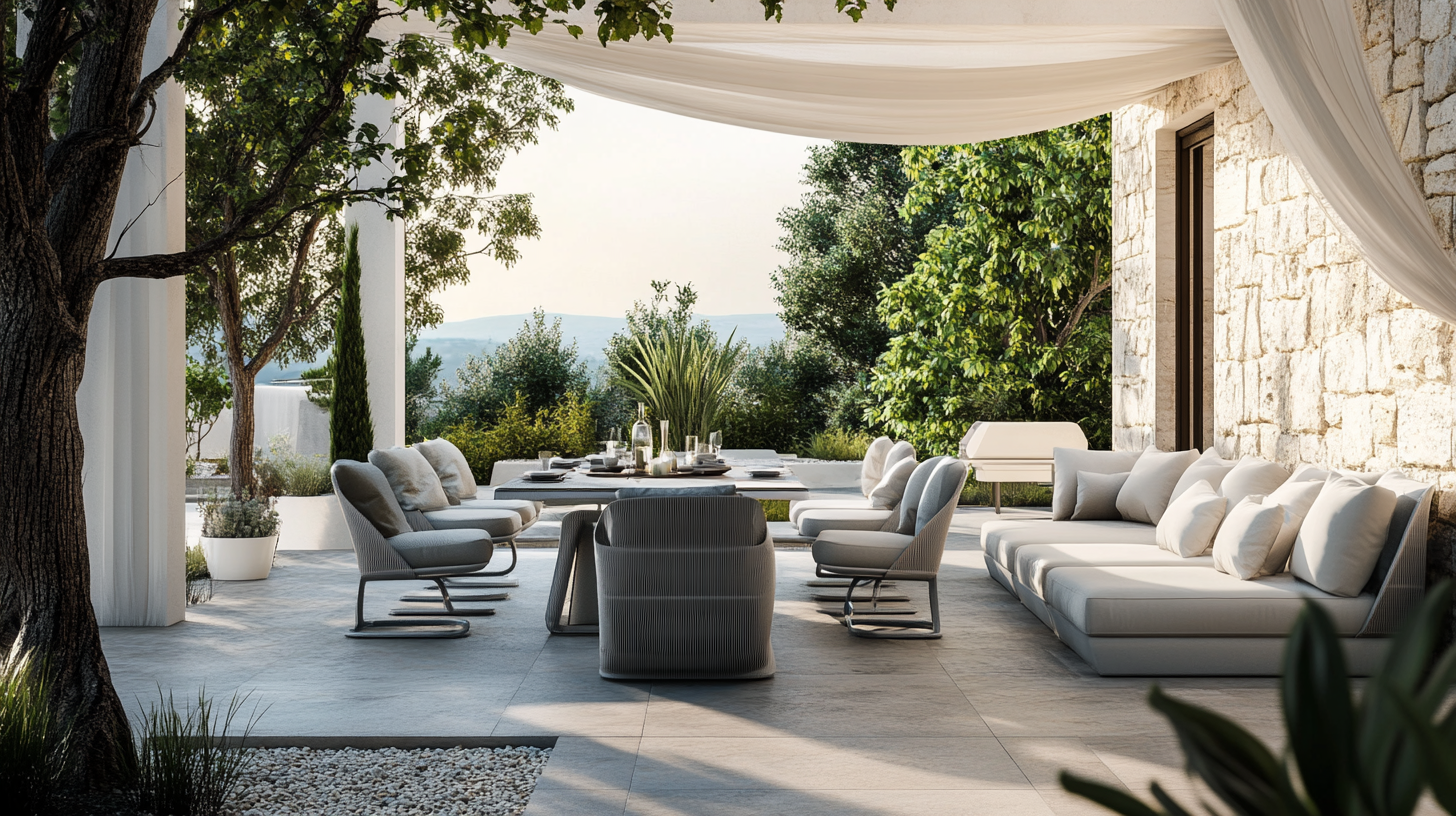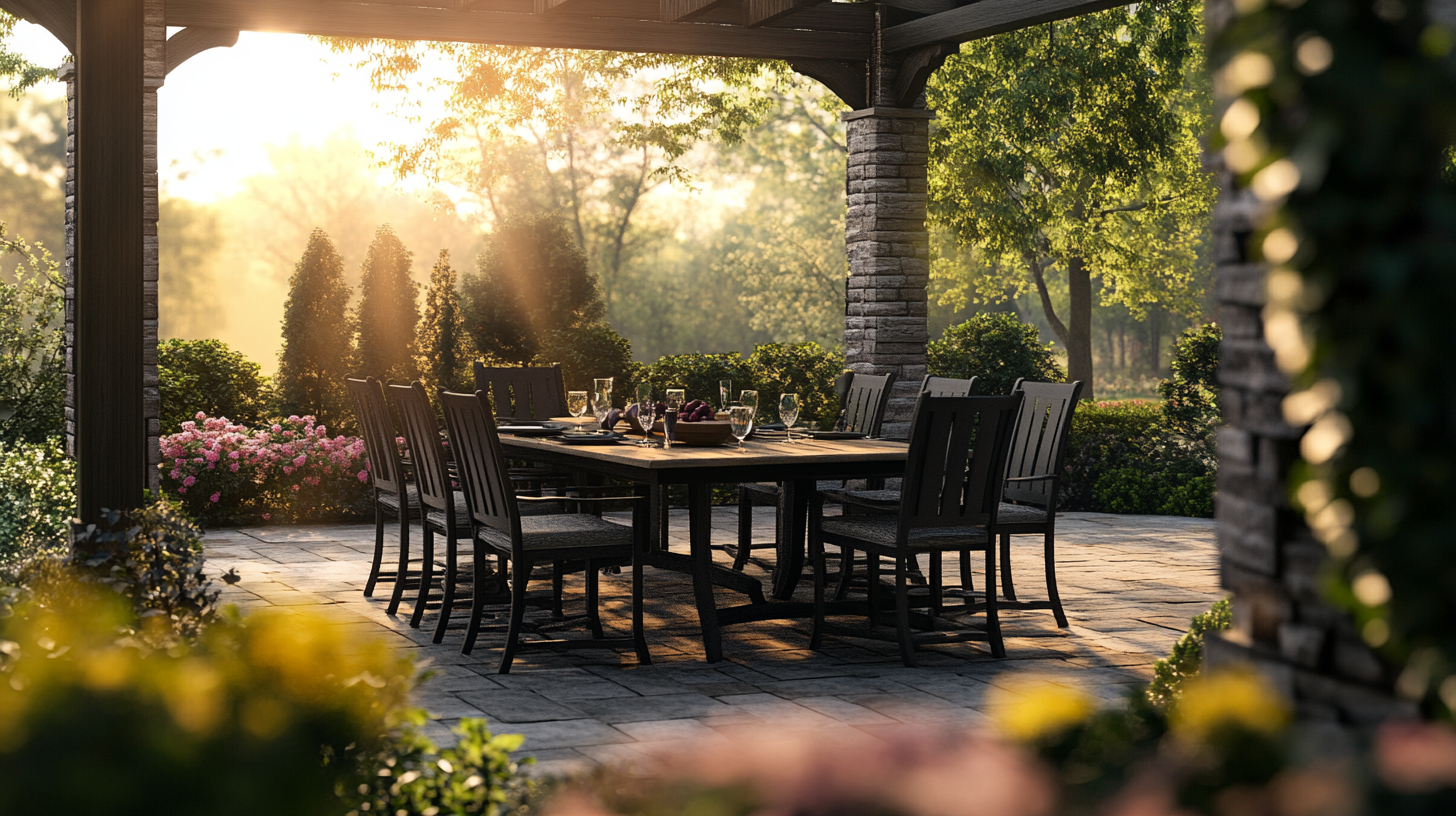Web Menu
Product Search
Exit Menu
Discovering the Future of Outdoor Dining Sets in 2025 Trends and How to Elevate Your Space
As we look toward 2025, the outdoor dining sets industry is poised for remarkable transformation, driven by evolving consumer preferences and innovative designs. According to a recent market analysis report by IBISWorld, the outdoor furniture market is anticipated to grow at a compound annual growth rate of 5.8%, reaching a valuation of approximately $10 billion by 2025. This surge is fueled by the increasing emphasis on outdoor living spaces as extensions of homes, prompting consumers to seek stylish and functional dining sets that enhance their outdoor experiences. In this blog, we will explore the latest trends shaping outdoor dining sets, the impact of import and export certification standards on product quality, and provide actionable insights on how to elevate your space to reflect these exciting developments in outdoor dining.

Emerging Trends in Outdoor Dining Sets for 2025: A Comprehensive Analysis
As we step into 2025, the outdoor dining scene is poised for a transformation driven by emerging trends that blend aesthetics and functionality. Designers are increasingly favoring modular furniture that offers adaptability to various outdoor spaces, allowing homeowners to reconfigure their setups for gatherings or intimate meals. The emphasis on sustainability is also prominent, with eco-friendly materials becoming a staple in outdoor dining sets. These innovations not only enhance the visual appeal but also contribute to a more environmentally-conscious lifestyle.

In addition, color palettes are evolving, with bold and vibrant hues taking center stage. These colors, paired with unique textures and finishes, will help create inviting outdoor environments that encourage social interaction. The incorporation of smart technology into outdoor dining sets is another trend to watch, as consumers look for convenience and enhanced outdoor experiences. Overall, the future of outdoor dining sets is bright, with a perfect blend of style, sustainability, and smart design, setting the stage for unforgettable dining experiences under the open sky.
Comparing Materials: Wood vs. Metal Outdoor Dining Sets in 2025
As we look toward 2025, outdoor dining sets are set to evolve in both design and functionality. One of the key considerations for homeowners is the choice between wood and metal materials. Each offers distinct advantages that cater to varying aesthetic preferences and practical needs.

Wooden outdoor dining sets provide a warm, natural look that effortlessly blends into garden environments. They evoke a sense of rustic charm and comfort, perfect for family gatherings over a summer meal. Popular choices like teak and eucalyptus are not only durable but also age beautifully, developing rich patinas over time. However, they require regular maintenance to preserve their appearance and longevity, making them best suited for those willing to invest time in care.
On the other hand, metal outdoor dining sets are gaining traction for their sleek, modern appearance and robustness. Aluminum and wrought iron options are particularly appealing for their weather resistance and minimal upkeep. These materials can be coated in various finishes, providing versatility in color and style while remaining lightweight enough for easy rearrangement. As trends evolve in 2025, the preference for low-maintenance, stylish designs will likely skew towards metal, appealing to busy homeowners who want to maximize their outdoor enjoyment without extensive commitment to upkeep.
The Impact of Sustainability on Outdoor Dining Set Design Trends
As we approach 2025, the impact of sustainability continues to reshape the landscape of outdoor dining set design. Today’s consumers are increasingly mindful of their ecological footprint, driving manufacturers to prioritize sustainable materials and practices. This shift is evident in the rise of outdoor furniture made from reclaimed wood, recycled plastics, and even innovative materials like bamboo. These elements not only contribute to a greener planet but also provide an aesthetic appeal that fits harmoniously into natural settings.
Moreover, sustainability in outdoor dining sets goes beyond materials; it encompasses the entire design philosophy. Brands are embracing modular designs that allow for flexibility and adaptability, ensuring that furniture can be repurposed or reconfigured as needed. This approach not only minimizes waste but also enhances the longevity of the products. In 2025, consumers will likely seek pieces that offer both versatility and sustainability, allowing them to create inviting outdoor spaces that reflect their commitment to environmental consciousness while enjoying the beauty of nature.
Discovering the Future of Outdoor Dining Sets in 2025 Trends and How to Elevate Your Space - The Impact of Sustainability on Outdoor Dining Set Design Trends
| Trend | Material | Sustainability Factor | Design Style | Color Palette |
|---|---|---|---|---|
| Biophilic Design | Recycled Aluminum | High | Natural | Earth Tones |
| Minimalist Aesthetics | Bamboo | Medium | Modern | Monochrome |
| Modular Furniture | Reclaimed Wood | Very High | Contemporary | Warm Neutrals |
| Smart Furniture | Sustainable Plastics | Medium | Futuristic | Bright Accents |
| Colorful Outdoor Spaces | Eco-friendly Fabrics | High | Eclectic | Vibrant Colors |
Consumer Preferences: High-End vs. Budget-Friendly Outdoor Dining Solutions
As we step into 2025, the outdoor dining market is expected to flourish, reflecting diverse consumer preferences across various budgets. According to a recent report by the Outdoor Industry Association, spending on outdoor furniture is projected to grow by 10% annually, highlighting a rising appreciation for both high-end and budget-friendly solutions. Consumers are increasingly drawn to high-quality materials and stylish designs that offer longevity, while budget-conscious buyers seek durable yet affordable options that enhance their outdoor experience without breaking the bank.
The trend towards personalized outdoor spaces also reflects a shift in consumer behaviors. A survey by Research and Markets shows that 60% of consumers prioritize customization in outdoor living products. This has led brands to offer versatile options that cater to both upmarket and economical tastes, ensuring that everyone can create their ideal dining atmosphere.
Tips: Don’t forget about accessories and modular designs that can adapt to your specific needs, allowing you to elevate your space without a complete overhaul. Incorporating features like extendable tables or stackable chairs can maximize functionality, regardless of your budget.
Future-Proofing Your Outdoor Space: Key Features to Consider for 2025
As we look towards 2025, outdoor dining sets are becoming increasingly sophisticated, blending style with functionality. Industry reports indicate that the outdoor furniture market is projected to reach $23 billion by 2025, driven by consumer demand for versatile, durable, and aesthetically pleasing outdoor spaces. To future-proof your outdoor living area, it's essential to focus on key features that enhance both design and practicality.
One major trend emerging is the use of sustainable materials. According to a recent study by Grand View Research, nearly 60% of consumers prioritize eco-friendly products when making purchases. Incorporating furniture made from recycled or sustainably sourced materials not only aligns with environmentally conscious consumer behavior but also adds a unique touch to your outdoor space.
**Tip:** Consider modular dining sets that can be easily reconfigured for different occasions, catering to both intimate gatherings and larger parties. Additionally, integrating smart technology, such as weather-resistant speakers or ambient lighting, can elevate the dining experience, making it both stylish and functional—something that 45% of homeowners are looking for in their outdoor setups, as noted by the latest industry insights. Embracing these features ensures your outdoor area remains a desirable retreat for years to come.
Trends in Outdoor Dining Sets for 2025
-
- about us
- About Us
- Qualification
- Privacy
-
- Packaging products
- Hot Sale
- Outdoor Sofa Sets
- Outdoor Dining Sets
- Outdoor Loungers/Sunbeds
- Swing Chairs
- Single Chair

 English
English España
España عرب
عرب 简体中文
简体中文